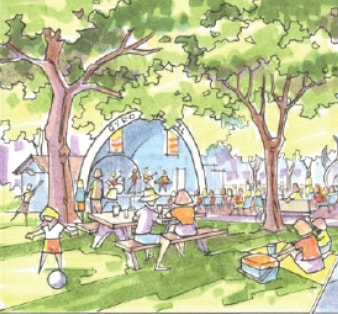By the end of 2016, Penticton’s Main Street is going to look a lot different.
Penticton City Council voted at their Oct. 4 meeting to move ahead with revitalization plans for the 100 and 200 blocks of Main Street at a cost of $4.3 million.
“It’s been about three years and counting as we move forward,” said Barb Haynes, chair of the Downtown Select Revitalization Committee, who said that after all that time and energy spent trying to determine the wants of the community, the committee decided the northern end of Main Street was the place to start.
“We want it to be a visually enhanced space, particularly in the 100 block since it is surrounded by green space and park space,” said Haynes. “We know that it needs to be a convertible space, something that can be used, not just for one idea but for many.”
The plan laid out for council Monday evening shows similar improvements to those made last year on Martin Street, with paving stones replacing concrete sidewalks, along with additional street trees, planting beds, benches, bike racks and other amenities.
The portion of the street next to Gyro Park will be getting special treatment, acknowledging it is commonly closed off for events like the Farmers Market, Challenge Penticton or the Gran Fondo bike race.
In that section, the asphalt road surface will also be replaced with paving stones and raised to be level with the sidewalk areas. A light canopy is also planned for overhead.
To make it easier to close that section of the street off, a link road between Main and Martin Street will be constructed to divert traffic.
Main Street will also be narrowed to two lanes through both blocks to make room for wider sidewalks, especially in front of city hall, where 66 angled parking spots are to be replaced with parallel parking, for a total of 46 spots on both sides of the road instead of the current 94.
“If you walk out in front of city hall right now, you have a pretty small sidewalk in front of a major civic facility. It was felt it was important to make that sidewalk bigger,” said director of operations Mitch Moroziuk, who suggested the loss of 48 parking spots could be ameliorated by dedicating 18 spots behind City Hall to public parking, where they can access the building’s rear entrance.
“You have to retrain your public. The public would still have a place to park,” said Moroziuk.
Haynes said the committee continually heard from the community and individuals that wanted them to consider not planning the space around vehicles, but planning it around public use.
Moroziuk said about $2.7 million of the total $4.3 million cost is expected to come from grants, with the remaining $1.7 million coming from a variety of the city’s accounts, reflecting the water and power infrastructure work that will be done as part of the project, like replacing the old cast iron water mains.
Should the grants not come through, Moroziuk suggested the shortfall could be made up by the city transferring funds from other projects, increasing the contribution from land owners or borrowing the money.
Coun. Helena Konanz, the only council member to vote against the plan was concerned about the cost to do just two blocks of the six that will eventually get the same treatment.
“I think this is a beautiful plan, but to me it is kind of a Cadillac plan. I think that more than $2 million a block is just too much to spend on this project right now. I was hoping it would be closer to $1 million and that would have been quite a bit,” said Konanz. “I think maybe we need to reel it in a little bit.”
Coun. Judy Sentes, who is council’s representative on the revitalization committee, said discussions about the cost and plans had already been done.
“We have had this discussion many times and we have voted to move it forward. This has been decided and we are moving it forward,” said Sentes, adding that the community would be “greatly disappointed” if council unraveled the plan.
Coun. Campbell Watt, who has sat on the Revitalization Committee said cuts had already been made in the planning process.
“I believe this looks like a Cadillac plan, but I believe it looks like that because of the time and effort the committee and staff and DPA has put into it,” said Watt, who was supported by Coun. Max Picton who didn’t want to cut corners on a plan the city would have to live with for 40 or 50 years.
Moroziuk expects the plan to go out to tender in January 2016, with work beginning in April. Construction will stop during the tourist season, and resume in September, with completion expected in November 2016.
